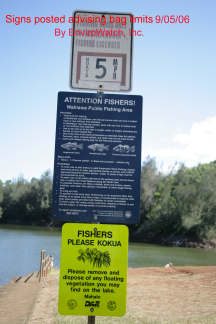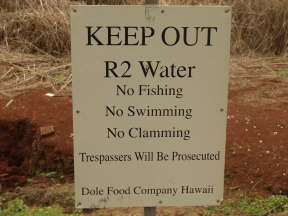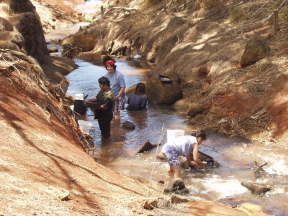DLNR and DOH – A Toxic Combination,
or, the Big Fish gets away
PART III
Facts About theWahiawa Waste Water Treatment Plant
The DLNR is further remiss in their failure to prosecute the City and County of Honolulu for the illegal dumping of raw sewage into state waters as a result of the many spills and discharges of effluent treated wastewater from the Wahiawa Wastewater Treatment Plant into the Kaukonahua stream. Hawaii Administrative Rules, Section 11-54-04(a)(3), states “all waters shall be free of substances attributable to domestic, industrial, or other controllable sources of pollutants, including substances in amounts sufficient to produce taste in water or detectable color, turbidity or other conditions in the receiving waters.” If there is no enforcement authority in this matter, why haven’t we seen an effort by the DLNR to initiate legislation to give them enforcement powers over laws such as these?
As you may recall, the Wahiawa Reservoir has had its share of problems with salvinia and hyacinth, both alien aquatic plants. These two species were able to grow out of control because the water in the reservoir is rich in nitrogen. So, if the DLNR and the DOH permit the City and County of Honolulu, the United States government, and Dole Foods Hawaii to dump this exact same effluent into the Kaukonahua stream, that eventually end up in the ocean at Kaiaka Bay on the north shore, will the nitrogen laden water that provided such a rich and fertile food source for the salvinia and the hyacinth become a food source for the alien or gorilla ogo that we are now having problems with around the island, or cause sores and tumors on fish and sea turtles? Will the discharge by Dole cause a turbid plume when it enters Kaukonahua Stream and eventually making its way to the ocean where we might see algal blooms as we see in the waters of Waimanalo?
In 2002 the Department of Health conducted a “Level I” preliminary sampling of contaminants in fish for risk assessment. The test results indicated some concern and a “Level II” test was recommended. As of October 2006 no Level II testing had been done. On October 6, 2006, the Pacific Justice Center filed a sixty day notice letter of intent to sue the DOH, on behalf of EnviroWatch, Inc., for failure to enforce the Constitution of the State of Hawaii, Chapter 342D and other applicable Hawaii Revised Statutes, the Clean Water Act, and the Toxic Substance Act. To date we have not been advised by the DOH if the Level II test has been conducted.
It was reported the state spent over a million dollars to clean up the salvinia. The project also afforded many photo opportunities for the mayor, the governor, state officials and the Dept. of Defense for their help in the cleanup. But, all along, the DOH has had knowledge that, lying just inches below the salvinia, there were fish with a high level of contaminants that should have been a cause for concern. Yet they did nothing, even after testing confirmed the contaminants. The sad part of the story is, it would only cost around $35,000 to conduct a level II test.
Unfortunately, the DLNR was preoccupied with the fact that they did not want to kill off fish because it would hurt the recreational fishing industry. Though the DLNR was concerned that the salvinia was unsightly, they were more concerned that if it killed the fish, it would cause a stink and impede fishermen from catching fish.
But, the fish are so contaminated they are not worth catching. To make matters worse, all the DLNR did was put up confusing signs about bag limits for certain species. The term “Bag limits” is construed to mean you can put the fish in a bag and take them home to eat, not catch them, bag them and waste them. From my interviews with fishermen around the reservoir, we have learned firsthand that some of them eat and sell the fish they catch from the Wahiawa Reservoir.

|
We became even more concerned when, on several occasions, we witnessed individuals wading in the irrigation ditch that leads out of the reservoir. They were gathering clams to be eaten or sold. We believed that human consumption of the clams was a potential health risk and the public should be notified. Therefore, we requested that signs in various languages be posted along the irrigation ditch to inform the public about the health risk associated with eating the clams and coming in contact with the water.
 |
 People gathering clams in irrigation flume |
It is not just our opinion that the discharge of water from the Wahiawa Reservoir is wrong. Here is a portion of a July 16, 2002, letter Mr. Gary Gill, Deputy Director of the DOH, wrote to Mr. Gilbert Coloma-Agaran, Chairman of DLNR.
“The Department of Health has received several complaints regarding muddy water discharges and disturbing odors due to discharges from behind the dam at Lake Wilson. On June 25, 2002, an inspection revealed water flowing from an open pipe below Lake Wilson. There is no National Pollutant Discharge Elimination System (NPDES) permit authorizing the discharge. It is our understanding that the discharge is controlled by Dole Food Company Hawaii, and that the water being discharged comes from the bottom of Lake Wilson. The Department requested that the Department of Land and Natural Resources and Dole cease the discharge of muddy waters in present capacity and, if it is necessary to continue the discharge, release water from a higher level in Lake Wilson where the water quality is better.”
Once again, these observations beg the question, what exactly is the DLNR doing about pollution from these facilities, and others like them, that are doing irreparable harm to our fish, our oceans, and our environment?
 |
|
CONCLUSION
Who is protecting our resources from the major polluters and polluting sources? These examples are only a few of the problems that we have documented. These practices are repeating themselves throughout our Islands. Pollution, runoff, and carelessness from the big offenders does a lot more damage than the weekend fisherman out catching a few with his buddies and kids. How many fish can you get in your ice chest?
There is a lot of talk that the outfalls from the sewage treatment plants are not a problem. They say that the treated effluent is within acceptable levels. But, how often do we hear about spills from the various treatment plants? How often are Lake Wilson, Kaneohe Bay and Sand Island in the news with yet another spill? Is the DLNR searching those facilities and enforcing pollution laws? How about Mayor Hannemann dumping 48 million gallons of sewage into the Ala Wai? Are they searching his office, his brief case or his car?
The Hawaii State Department of Health and the Department of Land and Natural Resources can best be described as toothless paper tigers. They give big business, potential employers and family friends the kid glove treatment while shredding and attacking the basic rights afforded the rest of us by the Constitution of the United States - under the pretense of protecting a fish caught out of season or one that is undersize.
We are being warned about global warming and the greenhouse effect on our environment. But, all the while there is a melt down in the State of Hawaii Department of Health and the Department of Land and Natural Resources. I wish I could have reported that there was a ray of hope with our legislators and the Executive Branch of our government. But, all we can report is that their approach to these matters is the introduction of legislation that can only be viewed as self-serving smoke and mirrors, and a lot of hot air.
………Carroll